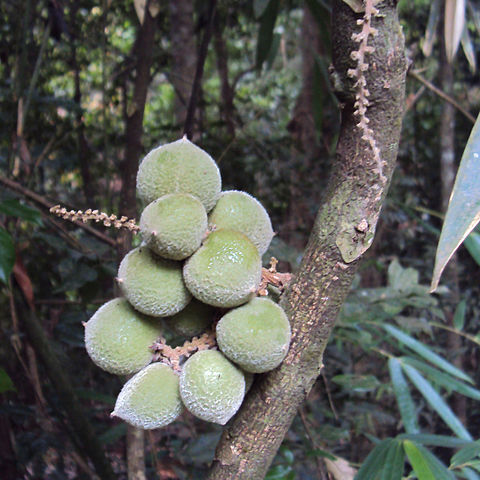Mostly a shrub or treelet, sometimes a tree up to 22.5 m high, dbh up to 60 cm. Twigs terete (to angular), up to 2.5 cm in diam., glabrous or variably fulvous to ferrugineous hairy, mostly early gla-brescent, usually at first dark (purplish) brown, later on often greyish brown, mostly conspicuously len-ticellate. Leaves 2-10-jugate, axial parts glabrous or variably hairy; petioles 5-50 cm long; petiolules 2-25 mm. Leaflets lanceolate to elliptic, ovate to obovate, 7-55 by 2-10(-20) cm, chartaceous (per-gamentaceous), glabrous or variably hairy; base slightly (or strongly) oblique to equal-sided, acute to rounded (or subcordate); apex tapering to abruptly acuminate, acumen short to long, obtuse to acute; nerves variable, at least the upper ones (rarely all) looped and joined or exceptionally connected by an intramarginal vein, above prominulous or sometimes sunken, beneath prominulous to prominent, intercalary veins variable, veins and veinlets finely reticulate. Inflorescences 2-70 cm long, variably, mostly shortly and densely hairy, hardly to long peduncled, the main branches often racemous; cymes patent, sessile or up to 0.5 cm long stalked, up to c. 7-flowered; bracts ovate-lanceolate to subulate, up to 5 mm long, rarely ovate and up to 7 by 6 mm; pedicels up to 6 mm. Flowers white, sometimes greenish white, cream, or pink, sweet-scented. Sepals: outer ovate to suborbicular, 1.2-7 by 1.2-6 mm, densely (sometimes partly glandular-)ciliolate, inside glabrous (to sparsely hairy); inner 3 elliptic to orbicular, ovate to obovate, 2.2-6.2 by 1.8-6 mm, margin mostly narrow (to broad) petaloid, outside glabrous, crenulate to fimbriate-denticulate, indument otherwise like outer sepals. Petals 2.2-10 mm long, claw 0.5-2(-4) mm long, blade elliptic to oblong to ovate, 1.2-4 mm wide, more or less dentate in the upper part, outside mostly up to ⅔ sericeous, rarely subglabrous, margin glabrous or below insertion of scale sparsely to densely woolly-ciliate, rarely rest of the blade (partly glandular-)ciliate, inside glabrous or the claw (rarely also the base of the blade) sparsely hairy; scale mostly well-developed (rarely a hairy rim only), entire to deeply 2-4-lobed, glabrous, cili-ate, or inside sparsely to densely woolly, without or more often with a crest which may vary from a small wart (then often present only in some of the petals of a flower) to a deeply bilobed duplication of the scale or to 2 brushes. Stamens: filaments 1.5-6.5 mm, sparsely to densely woolly, mostly mainly in the upper, rarely in the lower half; anthers (broad-)elliptic to oblong, ovate to obovate, 0.8-2.5 mm, connective broad and obtuse (rarely narrow and/or pointed), woolly to glabrous. Ovary and lower part of style densely hairy (to subglabrous). Fruits green when young, later yellowish, grey, or greyish pink (ripe?), flattened ellipsoid, shortly obovoid, or subglobular, slightly lobed, the lobes rarely carinate, 1.5-5 cm in diam. Seeds brown, testa papery, probably partly fleshy when fresh.
More
A shrub 2-8 m high. It can be a tree 23 m high. The trunk can be 60 cm across. The leaves are alternate and compound. The leaves have 2-10 leaflets on each side of the stalk. The leaflets are sword shaped or oval. The leaves are 7-55 cm long by 2-10 cm wide. The flowers are 10 mm across. The flowering clusters can be 2-70 cm long. The fruit are flattened and oval. They are slightly lobed. They are 2-5 cm across. They are densely hairy.


